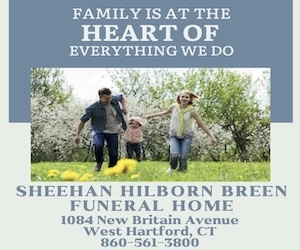
Beth Israel Synagogue outside
By Cindy Mindell
-NORWALK – Beth Israel Synagogue of Westport/Norwalk was selected as one of 13 synagogues featured in films exploring the role of synagogues built after World War II in the U.S. Located in the museum’s core exhibition, which explores Jewish life from 1945 to the present, the films are virtual tours of the synagogues that immerse visitors in inspirational and diverse examples of 20th-century synagogue architecture. The films appear in a section of the exhibition relating to the movement of American Jews into suburban neighborhoods in the post-war years, when the synagogue became a focal point of American Jewish life.
“Our intention was to highlight the two decades following World War II, a tremendous and important period in American Jewish communal development,” says Dr. Josh Perelman, the museum’s deputy director for exhibitions, programs, and collections.
“It’s a pivotal moment with a great number of Jews and others moving from urban centers into the suburbs, and many Jews were moving to new neighborhoods with no pre-existing communities. We tend to think of ‘pioneering’ as being a 19th-century phenomenon, but this is also an important moment of Jews pioneering new communities. Jews had lived in cities where whole neighborhoods were Jewish, with a Jewish ethos, and where one could easily be Jewish and live a Jewish life without necessarily entering a synagogue. In the suburbs, this changes radically: people move into more integrated neighborhoods and Jews, along with their Christian neighbors, wrestle with how to make meaningful communal bonds. The synagogue becomes central to how the community is organized and how it functions.”
Between 1945 and 1965, American Jewish communities throughout the U.S. built, or rebuilt, more than 1,000 synagogues, which often became centers for individual Jewish identity as well as important educational and social hubs for the community.
“What was fascinating about those synagogues was that many of them are so magnificent in their architecture,” says Perelman. “Jews were thinking critically, not only about communal and sacred space, but about aesthetics. They were using some of the most prominent modern architects of the times and challenging them to merge cutting-edge aesthetics and the traditional format of sacred space.”
Perelman says that the museum chose the 13 synagogues based on three criteria: aesthetics, geography, and denominational ecumenicism.
“We highlight a number of different synagogues which are rich and beautiful and majestic in their look and construction; we selected synagogues from : communities throughout the U.S.; and we chose synagogues from different denominational streams,” he says.
In summer 2009. filmmakers from Manhattan-based Local Projects, the museum’s interactive media partner, filmed the interior and exterior of Beth Israel. The synagogue, dedicated in 1973, exemplifies the work of Percival Goodman, an American urban theorist and architect who designed more than 50 synagogues from 1948 to 1983. Trained in Paris at …cole des Beaux Arts, Goodman has been called the “leading theorist” of modern synagogue design and “the most prolific architect in Jewish history.”

Beth Israel sanctuary
“Beth Israel Synagogue marries two important considerations: the period; it was built at the right time and contains some aesthetic considerations we wanted to highlight, and the congregation is a traditional one,” Perelman says. “Goodman was one of the most important modernist synagogue architects whose buildings generally were built to serve Reform and Conservative communities, but here’s a traditional community living in a Goodman building.”
Local Projects also taped audio interviews with a range of veteran and recent members of the congregation. “The opportunity to collect these voices as snapshots of Jewish American life for the museum has been an incredible experience for our team of filmmakers,” says Jake Barton, Local Projects principal. “The interviews have revealed incredibly warm and candid expressions of congregants’ connection, not only to Judaism and their synagogue, but to their family and in some instances, to their larger Jewish identity.”
“Beth Israel is the mother of all the Jewish congregations of mid-Fairfield County,” says Rabbi Yehoshua S. Hecht, who has served the synagogue since 1984. “Today, six area congregations can trace their roots to the original Beth Israel Synagogue.” Plaques in the sanctuary bear names of the oldest and most renowned Jewish families in the community, Hecht says.
The Orthodox congregation’s first home was built in 1906 at 31 Concord Street in South Norwalk and was added to the National Register of Historic Places in 1991. Now owned by Canaan Institutional Baptist Church, the Moorish Revival-style building is the only known remaining example of an urban wood-frame synagogue.
Hecht says that the relocation to the Norwalk-Westport border was spearheaded by Rabbi Israel Yavne, who recognized that the synagogue’s catchment area had shifted from urban Norwalk to the suburbs of Westport and Weston. The decision to sell the original building in 1972 was not easy, Hecht says, as three generations of Jewish families had worshipped at the original building. Some board members even discussed floating the structure down the Norwalk River to a new location.
While the building was under construction, the congregation used a trailer and an existing one-room schoolhouse. The original design included a classroom wing which was never built, either due to financial constraints or a decision to make do within the other synagogue spaces, Hecht says. Those include a sanctuary and adjoining social hall and kitchen, and three small spaces used as offices and a library.
Local Projects photographers were especially intrigued with Beth Israel’s natural, woodsy setting, Hecht says, and filmed the social hall and sanctuary lit up by the setting sun. The building is open and airy, with a vaulted ceiling and stained-glass windows in the sanctuary, and large windows in the social hall.
The congregation hopes to build a classroom wing and a mikvah. “While the film captures a ’70s-era synagogue, the shul’s major history has yet to be made,” Hecht says. “I believe Beth Israel will still be around 100 years from now.”
Hecht is planning a communal day trip to visit the National Museum of American Jewish History on Sunday, Jan. 23, “like ‘machatunim,'” he says, using the Yiddish word for “in-laws” to refer to the new relationship between Beth Israel and the museum. “A piece of our shul is now being featured on Independence Mall.” For details about the trip: www.bethisraelct.org / (203) 866-0534 / (203) 247-6289.








 Southern New England Jewish Ledger
Southern New England Jewish Ledger







